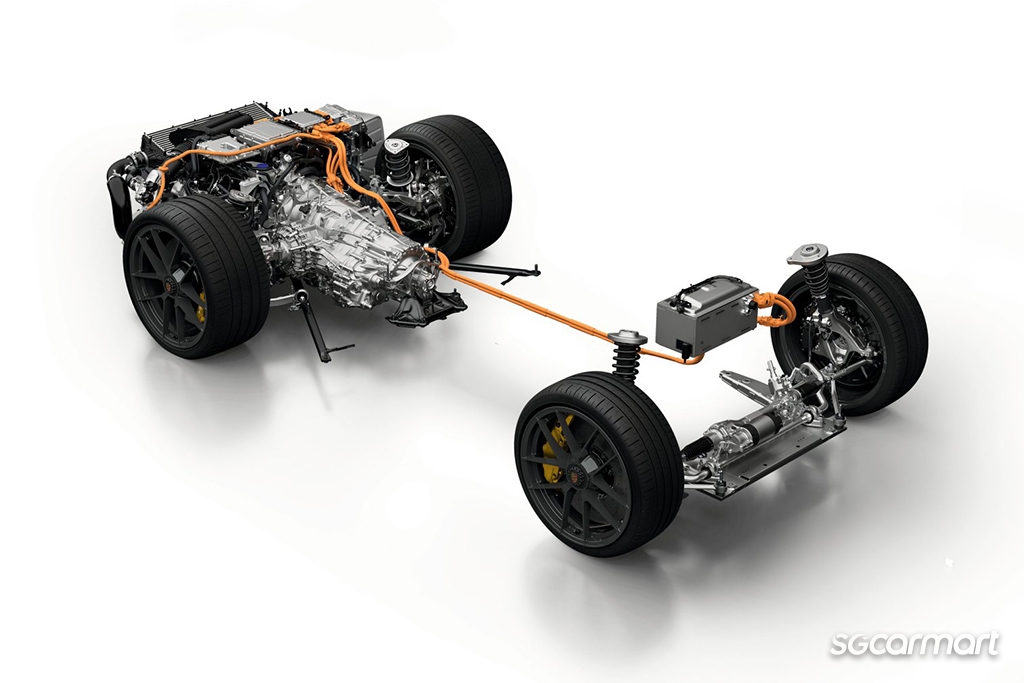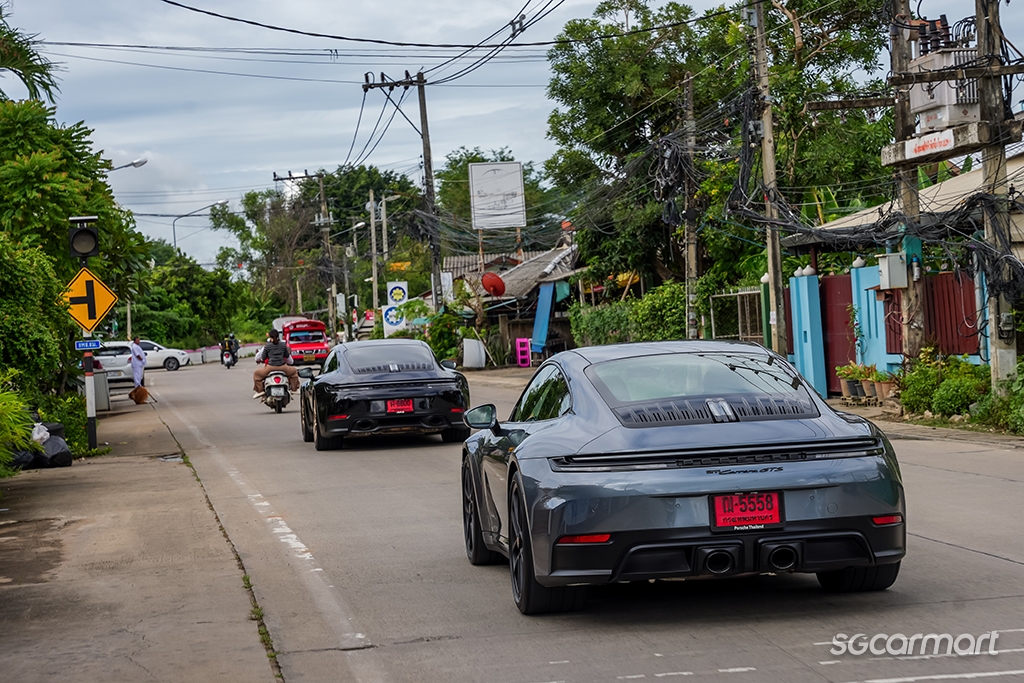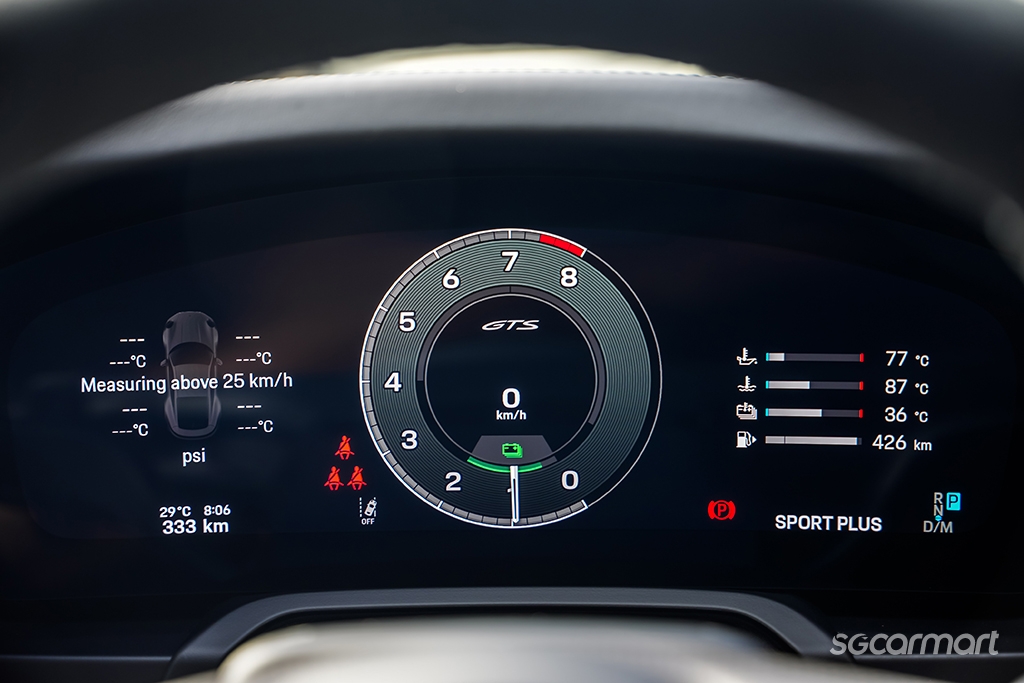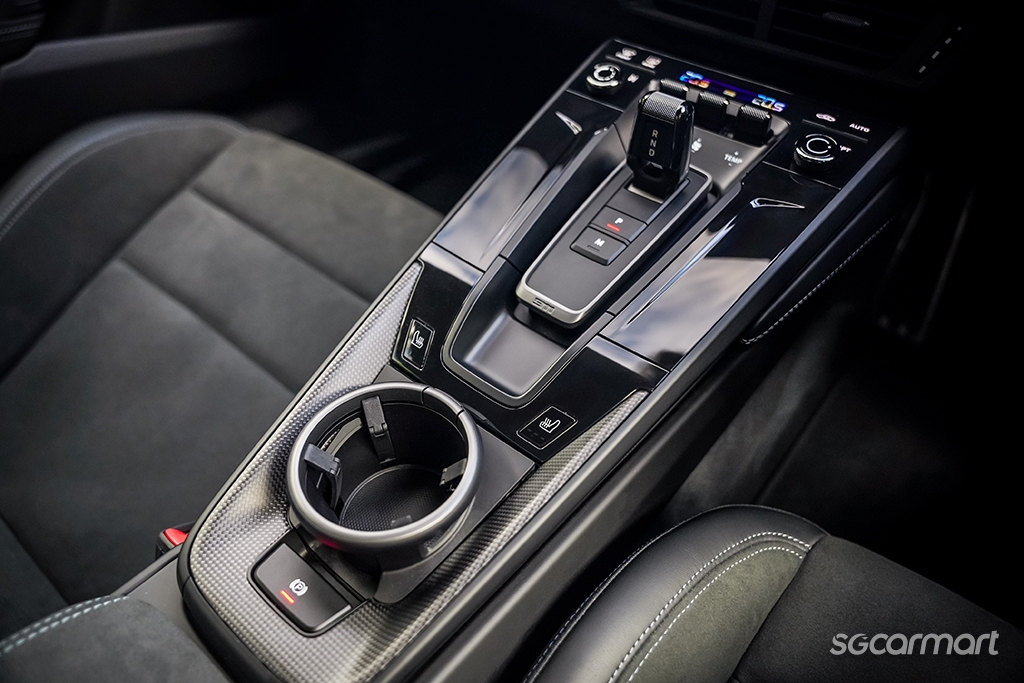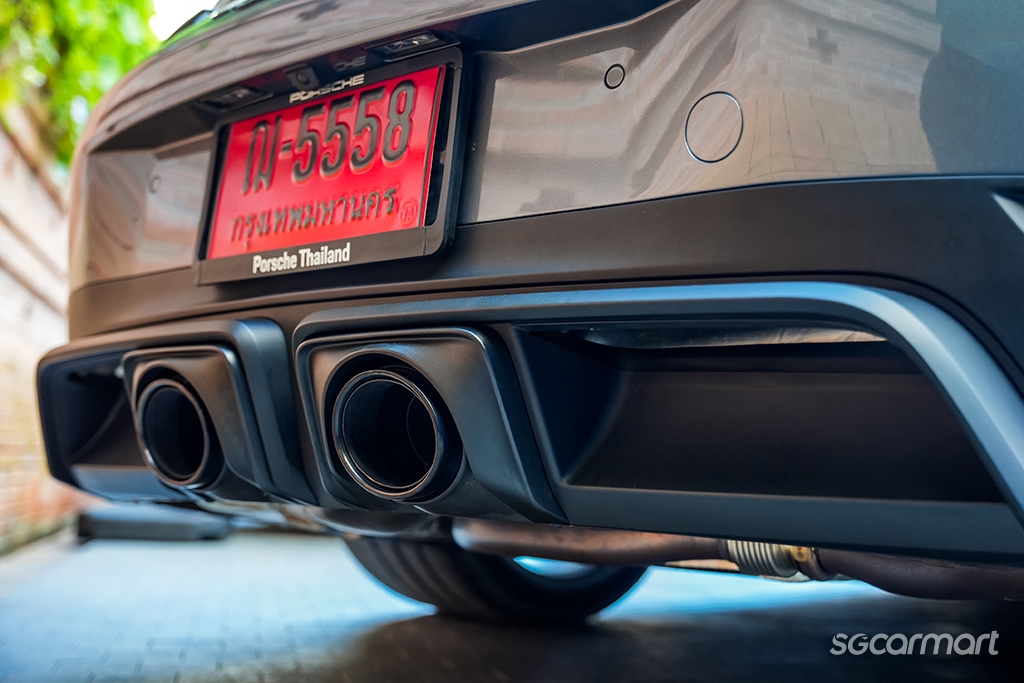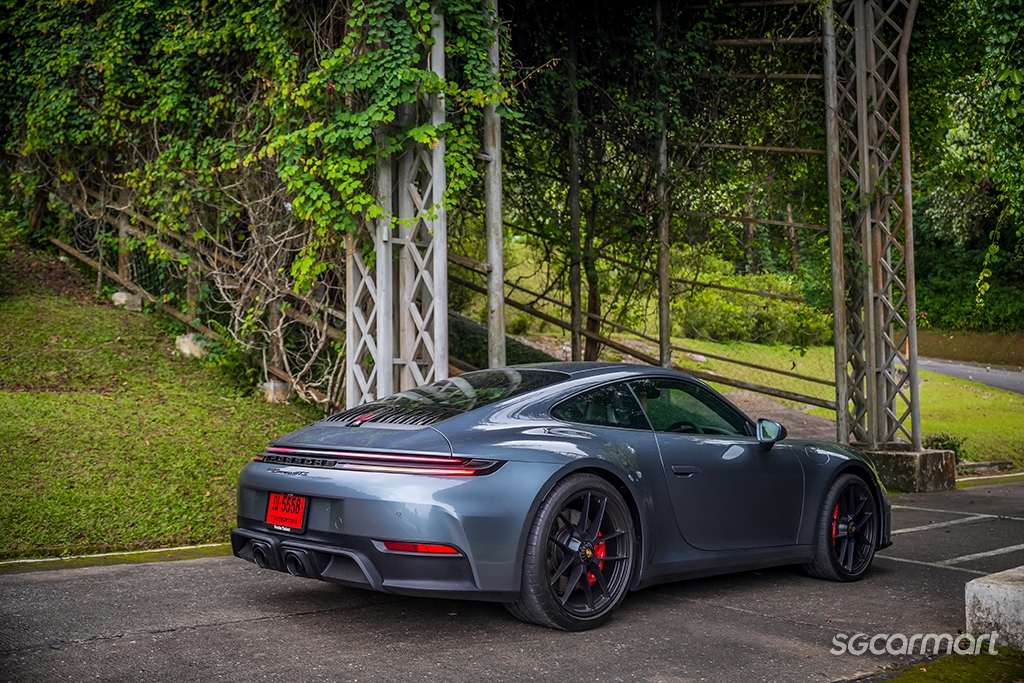Porsche 911 Carrera GTS First Drive Review
27 Jun 2025|1,867 views
What We Like
Urgent, lag-free powertrain thanks to electric assistance
Expectedly stellar steering and handling
A sports car you can use everyday
Seamless electric integration bodes well for the flat-six's future
What We Dislike
Can become a million bucks (sans COE) if you get handsy with the options
I'm not sure there's any group that's more up in arms about the introduction of new technology than 911 fans.
Four-wheel drive? Rubbish! Water-cooling? Heresy! Turbocharging? Salacious! Dual clutch gearbox and active aerodynamics? Appalling!
Yes, somehow the adoption of modern technology to amplify performance apparently sits wrongly with the most hardcore fans of … a sports car that's all about prioritising performance. Go figure.
Well, bring out those pitchforks once more, because it's now finally happened - the first electrified, hybrid 911.
Introducing the new 911 Carrera GTS.
Let's be very clear - electrification isn’t new for Porsche. In 2010, the Cayenne S Hybrid was launched. Plug-in hybrid versions of the Panamera and Cayenne also exist, and of course, full-electric models too (the Taycan is already six years old, and the new Macan is now electric). The upcoming Cayman/Boxster will be fully electric as well.
But the 911 yearns to hold on to its petrol-burning flat-six. And with tightening emissions standards, electrification was all but inevitable.
And so, Porsche brings us this new T-Hybrid powertrain.
In this application, a newly-developed 3.6-litre engine is boosted with an eTurbo, while a second electric motor in the PDK transmission means that system output stands at 534bhp and 610Nm of torque
The powertrain itself is quite a complex bit of kit. In this particular application, there is a newly developed 3.6-litre flat-six engine, which alone produces 471bhp. And instead of the twin-turbocharger setup found on the standard Carrera, here there is just the one turbocharger, dubbed the eTurbo. It is a much larger turbocharger that houses an electric motor that helps to quickly build boost pressure and effectively eliminate 'turbo lag'. The electric motor can also produce up to 11kW of power.
A second electric motor is integrated into the PDK transmission, and supports the engine with extra drive torque and can provide up to 40kW of power. Both electric motors also feed a 1.9kWh battery, which can also be charged through regenerative braking. In total, the system output on this 911 GTS stands at 534bhp and 610Nm of torque.
And yet, all that technical mambo jumbo actually doesn't immediately and obviously transform the road-going experience. It is a little strange then when you hit the start button, the engine immediately fires up without cranking, but once you set off, there's barely the hint of electrification.
That’s because this is no 'typical' or 'traditional' hybrid powertrain. There's no EV mode, no engine-off coasting, no cylinder deactivation, none of that eco business. Here, electrification is deployed almost entirely to augment performance. (In fact, you can think of this system more as a mild-hybrid on steroids, rather than a full self-charging hybrid à la the Toyota Prius.)
At low engine revs, there is a detectable difference - the car more immediately willing to gather speed compared to the standard Carrera. You can see the electric assistance in action on the dashboard, and yes there's an increased sharpness to the throttle response, with the revs piling on with no hint of lag at all. The increased low-end torque is evident when I purposely use a higher gear than I probably should (science, I swear). But again, this is hunting for differences. In a standard Carrera, the PDK will likely already have dropped a couple of gears to get the engine into the right power band.
But beyond that, the GTS experience is mostly distinguished by the elevated sense of performance (having over a 100 more horses certainly plays into it). 0-100km/h takes just 3 seconds, which is honestly probably much faster than anyone needs to do in their everyday sports car.
Whether it is attacking windy mountain roads or just trundling along in the city, the GTS hits a sweet spot - delivering intense performance, sharp handling, but also a reasonable amount of day-to-day comfort
With the lower, firmer suspension, more power on tap, and rear axle steering as standard, the GTS also swallows up windy tarmac with hilarious ease. Through corners, it is sharp and responsive, while still retaining the delectable driving nature of a rear-wheel driven 911.
Once at speed, the electrified nature of the car never crosses your mind. It's just a really quick, really agile 911 - simply put, it's a 911 GTS. Makes a great noise, too.
There are a few details that identify this car's electric nature (like the green battery meter), but otherwise it's pretty much a standard 992.2 generation cabin
Once you do deploy the (very good) brakes and come to a stop, you'll again struggle to find indications of this car's electrified nature within the cabin. Other than the green battery meter and the boost/recuperation meters in the tachometer, as well as the additional 'Energy' menu a couple screens down inside the infotainment system, everything is as you'd find in a standard 911. Well, "standard", considering the array of options available.
On this GTS model, Race-Tex is used quite extensively throughout the cabin (I quite like the material), and other than a few GTS designations here and there, it's pretty much just a 992.2 cabin.
Some people are going to have their qualms. I actually don't mind the fully-digital dashboard, though I still rather the turn-knob than just a generic engine start button. Otherwise, it's a lovely space - ergonomically ideal, comfortable and undeniably luxurious, and still fulfilling its important remit of being an everyday space.
Specific to the GTS model are the active air flaps on either side intake, as well as the centrally-arranged twin tailpipes
Step outside the car and there are some design elements that identifiably mark out this higher-performance 911 variant. The front air intakes feature vertically arranged air flaps that open/close depending on driving situations. I get the active aerodynamic element of it, but I find it visually cluttered, adding visual complexity to an otherwise quite simple and elegant silhouette.
At the rear, the GTS also gets centrally-positioned tailpipes (there are much wider set on the standard Carrera). I like how it looks. Full marks.
Once again, there are plenty of exterior options available - rear wing (nah), carbon elements (yes), fancy Matrix LED head lights (why not), and even a $131k Paint to Sample Plus option (you do you).
A lot of people are going to make a big deal about the 911 going hybrid, but in truth the most noticeable thing about this new T-Hybrid system is that you pretty much don't notice it at all. Yes, it works as advertised, helping to dial up even more performance, but in such a seamless and integrated way that you never really think about it at all. This is just a much quicker, much sharper 911 - entirely befitting of its GTS moniker.
The GTS is typically positioned above the Carrera variants and below the extreme Turbo and GT models. Here, this model finds a pleasing balance between outright performance and daily useability.
Of course, that won't come cheap. In Singapore, the GTS starts at $781,168 before COE (that's $211,900 more than a base Carrera). Get a little too handsy with the configurator and you can get perilously close to a million bucks in our current COE climate.
The new 911 GTS finds a sweet spot between performance and daily functionality, but that certainly will not come cheap
Some will bemoan modern technology and how it may dilute the "essentiality" of a car. But like it or not, the 911 has always adopted contemporary technology to attain new levels of performance.
With the new GTS, the pattern remains the same for Porsche - using new, modern technology to make the 911 more powerful, but also cleaner and in line with contemporary regulatory standards.
So put those pitchforks away. Driving the 911 GTS, it's easy to forget entirely about its hybrid powertrain. It just works exactly how you want and need a 911 too. For all the uproar, the reality is that it in fact still very much feels the same. The differences in driving character are in the margins. I'm quite convinced that if I taped up the battery meter and didn't tell anyone, they wouldn't be able to identify this as a hybrid powertrain. For all intents and purposes, it's just a 911 with performance turned up. It's... a 911 GTS.
And I can't say that I'm surprised. After all, despite the pitchfork-waving naysayers, Porsche's track record of getting these things right, especially with the 911, is pretty hard to fault.
Ignore the hoo-hah: The truth is that the hybrid system works effectively and almost-imperceptibly to raise performance and deliver a sharper and more potent 911
But the broader, long term implications of this T-Hybrid system are important.
This new technology is what will allow Porsche to continue to hold on to its flat-six, at least for some time to come. Just take Singapore for example - after 2030, only "cleaner energy" vehicles will be allowed to be sold. That means that without this T-Hybrid system, the 911 as currently constituted couldn't be sold here past 2030. Porsche hasn't come out to say it, but it's an obvious conclusion to draw that this T-Hybrid system will find its way into future 911 iterations, and perhaps other model lines as well. This allows Porsche to still be able to sell such cars in markets with stricter regulations.
That is what we must ultimately celebrate. As evidenced by the new GTS, Porsche has found a way to integrate electrification into its iconic sports car, thereby future-proofing it for some time to come, without altering its quintessential nature.
May the flat-six sing its special song for a long time more.
What We Like
Urgent, lag-free powertrain thanks to electric assistance
Expectedly stellar steering and handling
A sports car you can use everyday
Seamless electric integration bodes well for the flat-six's future
What We Dislike
Can become a million bucks (sans COE) if you get handsy with the options
I'm not sure there's any group that's more up in arms about the introduction of new technology than 911 fans.
Four-wheel drive? Rubbish! Water-cooling? Heresy! Turbocharging? Salacious! Dual clutch gearbox and active aerodynamics? Appalling!
Yes, somehow the adoption of modern technology to amplify performance apparently sits wrongly with the most hardcore fans of … a sports car that's all about prioritising performance. Go figure.
Well, bring out those pitchforks once more, because it's now finally happened - the first electrified, hybrid 911.
Introducing the new 911 Carrera GTS.
Let's be very clear - electrification isn’t new for Porsche. In 2010, the Cayenne S Hybrid was launched. Plug-in hybrid versions of the Panamera and Cayenne also exist, and of course, full-electric models too (the Taycan is already six years old, and the new Macan is now electric). The upcoming Cayman/Boxster will be fully electric as well.
But the 911 yearns to hold on to its petrol-burning flat-six. And with tightening emissions standards, electrification was all but inevitable.
And so, Porsche brings us this new T-Hybrid powertrain.
In this application, a newly-developed 3.6-litre engine is boosted with an eTurbo, while a second electric motor in the PDK transmission means that system output stands at 534bhp and 610Nm of torque
The powertrain itself is quite a complex bit of kit. In this particular application, there is a newly developed 3.6-litre flat-six engine, which alone produces 471bhp. And instead of the twin-turbocharger setup found on the standard Carrera, here there is just the one turbocharger, dubbed the eTurbo. It is a much larger turbocharger that houses an electric motor that helps to quickly build boost pressure and effectively eliminate 'turbo lag'. The electric motor can also produce up to 11kW of power.
A second electric motor is integrated into the PDK transmission, and supports the engine with extra drive torque and can provide up to 40kW of power. Both electric motors also feed a 1.9kWh battery, which can also be charged through regenerative braking. In total, the system output on this 911 GTS stands at 534bhp and 610Nm of torque.
And yet, all that technical mambo jumbo actually doesn't immediately and obviously transform the road-going experience. It is a little strange then when you hit the start button, the engine immediately fires up without cranking, but once you set off, there's barely the hint of electrification.
That’s because this is no 'typical' or 'traditional' hybrid powertrain. There's no EV mode, no engine-off coasting, no cylinder deactivation, none of that eco business. Here, electrification is deployed almost entirely to augment performance. (In fact, you can think of this system more as a mild-hybrid on steroids, rather than a full self-charging hybrid à la the Toyota Prius.)
At low engine revs, there is a detectable difference - the car more immediately willing to gather speed compared to the standard Carrera. You can see the electric assistance in action on the dashboard, and yes there's an increased sharpness to the throttle response, with the revs piling on with no hint of lag at all. The increased low-end torque is evident when I purposely use a higher gear than I probably should (science, I swear). But again, this is hunting for differences. In a standard Carrera, the PDK will likely already have dropped a couple of gears to get the engine into the right power band.
But beyond that, the GTS experience is mostly distinguished by the elevated sense of performance (having over a 100 more horses certainly plays into it). 0-100km/h takes just 3 seconds, which is honestly probably much faster than anyone needs to do in their everyday sports car.
Whether it is attacking windy mountain roads or just trundling along in the city, the GTS hits a sweet spot - delivering intense performance, sharp handling, but also a reasonable amount of day-to-day comfort
With the lower, firmer suspension, more power on tap, and rear axle steering as standard, the GTS also swallows up windy tarmac with hilarious ease. Through corners, it is sharp and responsive, while still retaining the delectable driving nature of a rear-wheel driven 911.
Once at speed, the electrified nature of the car never crosses your mind. It's just a really quick, really agile 911 - simply put, it's a 911 GTS. Makes a great noise, too.
There are a few details that identify this car's electric nature (like the green battery meter), but otherwise it's pretty much a standard 992.2 generation cabin
Once you do deploy the (very good) brakes and come to a stop, you'll again struggle to find indications of this car's electrified nature within the cabin. Other than the green battery meter and the boost/recuperation meters in the tachometer, as well as the additional 'Energy' menu a couple screens down inside the infotainment system, everything is as you'd find in a standard 911. Well, "standard", considering the array of options available.
On this GTS model, Race-Tex is used quite extensively throughout the cabin (I quite like the material), and other than a few GTS designations here and there, it's pretty much just a 992.2 cabin.
Some people are going to have their qualms. I actually don't mind the fully-digital dashboard, though I still rather the turn-knob than just a generic engine start button. Otherwise, it's a lovely space - ergonomically ideal, comfortable and undeniably luxurious, and still fulfilling its important remit of being an everyday space.
Specific to the GTS model are the active air flaps on either side intake, as well as the centrally-arranged twin tailpipes
Step outside the car and there are some design elements that identifiably mark out this higher-performance 911 variant. The front air intakes feature vertically arranged air flaps that open/close depending on driving situations. I get the active aerodynamic element of it, but I find it visually cluttered, adding visual complexity to an otherwise quite simple and elegant silhouette.
At the rear, the GTS also gets centrally-positioned tailpipes (there are much wider set on the standard Carrera). I like how it looks. Full marks.
Once again, there are plenty of exterior options available - rear wing (nah), carbon elements (yes), fancy Matrix LED head lights (why not), and even a $131k Paint to Sample Plus option (you do you).
A lot of people are going to make a big deal about the 911 going hybrid, but in truth the most noticeable thing about this new T-Hybrid system is that you pretty much don't notice it at all. Yes, it works as advertised, helping to dial up even more performance, but in such a seamless and integrated way that you never really think about it at all. This is just a much quicker, much sharper 911 - entirely befitting of its GTS moniker.
The GTS is typically positioned above the Carrera variants and below the extreme Turbo and GT models. Here, this model finds a pleasing balance between outright performance and daily useability.
Of course, that won't come cheap. In Singapore, the GTS starts at $781,168 before COE (that's $211,900 more than a base Carrera). Get a little too handsy with the configurator and you can get perilously close to a million bucks in our current COE climate.
The new 911 GTS finds a sweet spot between performance and daily functionality, but that certainly will not come cheap
Some will bemoan modern technology and how it may dilute the "essentiality" of a car. But like it or not, the 911 has always adopted contemporary technology to attain new levels of performance.
With the new GTS, the pattern remains the same for Porsche - using new, modern technology to make the 911 more powerful, but also cleaner and in line with contemporary regulatory standards.
So put those pitchforks away. Driving the 911 GTS, it's easy to forget entirely about its hybrid powertrain. It just works exactly how you want and need a 911 too. For all the uproar, the reality is that it in fact still very much feels the same. The differences in driving character are in the margins. I'm quite convinced that if I taped up the battery meter and didn't tell anyone, they wouldn't be able to identify this as a hybrid powertrain. For all intents and purposes, it's just a 911 with performance turned up. It's... a 911 GTS.
And I can't say that I'm surprised. After all, despite the pitchfork-waving naysayers, Porsche's track record of getting these things right, especially with the 911, is pretty hard to fault.
Ignore the hoo-hah: The truth is that the hybrid system works effectively and almost-imperceptibly to raise performance and deliver a sharper and more potent 911
But the broader, long term implications of this T-Hybrid system are important.
This new technology is what will allow Porsche to continue to hold on to its flat-six, at least for some time to come. Just take Singapore for example - after 2030, only "cleaner energy" vehicles will be allowed to be sold. That means that without this T-Hybrid system, the 911 as currently constituted couldn't be sold here past 2030. Porsche hasn't come out to say it, but it's an obvious conclusion to draw that this T-Hybrid system will find its way into future 911 iterations, and perhaps other model lines as well. This allows Porsche to still be able to sell such cars in markets with stricter regulations.
That is what we must ultimately celebrate. As evidenced by the new GTS, Porsche has found a way to integrate electrification into its iconic sports car, thereby future-proofing it for some time to come, without altering its quintessential nature.
May the flat-six sing its special song for a long time more.
Thank You For Your Subscription.
- Electrified Performance
- Its Own Look
- Future Proof




















































